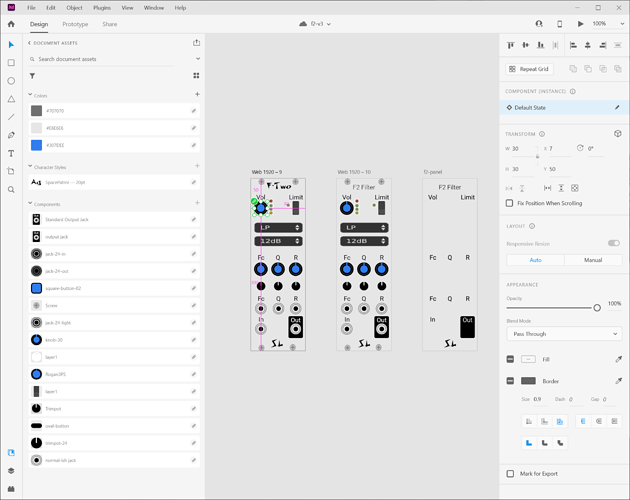@aetrion-music also uses XD to design VCV panels, and asked if I had any tips or clever workflows. No, I don’t, but here’s what I do.
TL;DR Adobe XD comes in two version, free and paid. The free one has all you need. XD is a “screen design” program. As such it competes against programs like Sketch and Figma. Screen design programs are made for doing this kind of thing, so they tend to be easier to use than vector drawing programs like Inkscape or Illustrator. They also are designed for multi-screen applicatations, and transitioning from scree to screen, which is not relevant at all to making a single panel.
Anyway, my panels are very basic, so I don’t need/use a lot of fancy features.
The thing that saves me a ton of time is that I long ago made a library of all the “components” I use in my panels. I have all the knobs, jacks, colors, and fonts that I use in a shared library.
To start a new project, I make a new document, and make a new folder to save it into. Then I load my component library. Lastly, I make a single artboard that’s the size of may panel. I fill it with my standard background color. Oh, by the way, I do everything in pixels because that’s what XD uses. Search this forum for more on pixels vs mm if you are interested.
Then I drag components out of the library panel, and onto my artboard. Most of the work is positioning the components so they look ok and line up. Maybe I will draw some simple things on the panel.
Then I take a screen capture and send it to testers for feedback. Once we agree I turn it into a VCV panel. To do that I:
- Save a copy of my project so I can mess it up for export.
- Make sure the artboard is named what I want the final svg to be named.
- Using the layers panel, hide all controls that will be later inserted programmatically.
- Keep visible only the panel decorations, and text.
- Convert all the text to paths, as XD does not have an option to do this on export.
- Export an SVG. I usually accept the defaults, and select “all artboards”, as that auto names my one artboard.
- Go into my source code and position every control. I do this the dumb way – read the x/y position from XD’s property pane and type it into my source code. Luckily XD uses upper/left as the anchor point, and that the most natural thing to do in VCV, too.
That’s about it. The thing I like about using XD for this, aside from the shared component library, it that there are not a bunch of palettes or property panes. The right side always shows you properties for the currently selected thing – you never need to go hunting or open multiples panes (get it – “pains”?).
Here’s what it looks like:

